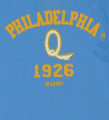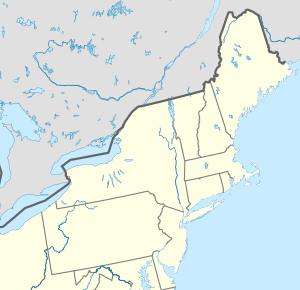
The Frankford Yellow Jackets were a professional American football team, part of the National Football League from 1924 to 1931, although its origin dates back to as early as 1899 with the Frankford Athletic Association. The Yellow Jackets won the NFL championship in 1926. The team played its home games from 1923 in Frankford Stadium in Frankford, a section in the northeastern part of Philadelphia, noted for the Market–Frankford Line that terminates there.

The Providence Steam Rollers were a professional American football team based in Providence, Rhode Island in the National Football League (NFL) from 1925 to 1931. Providence was the first New England team to win an NFL championship. The Steam Roller won the league's championship in 1928, which is the latest NFL championship win by a defunct team to date. Most of their home games were played at the Cycledrome, a 10,000-seat stadium that was built as a velodrome for bicycle races.

The Orange Tornadoes and Newark Tornadoes were two manifestations of a long-lived professional American football franchise that existed in some form from 1887 to 1941 and from 1958 to 1970, having played in the American Amateur Football Union from 1888 to 1895, the National Football League from 1929 to 1930, the American Association from 1936 to 1941, the Atlantic Coast Football League from 1963 to 1964 and 1970, and the Continental Football League from 1965 to 1969. The team was based for most of its history in Orange, New Jersey, with many of its later years in Newark. Its last five seasons of existence were as the Orlando Panthers, when the team was based in Orlando, Florida. The NFL franchise was sold back to the league in October 1930. The team had four head coaches in its two years in the NFL – Jack Depler in Orange, and Jack Fish, Al McGall and Andy Salata in Newark.
The 1925 NFL season was the sixth regular season of the National Football League. Five new teams entered the league: New York Giants, Detroit Panthers, Pottsville Maroons, Providence Steam Roller, and a new Canton Bulldogs team. The Kenosha Maroons folded, with the Racine Legion and Minneapolis Marines mothballing.

The Philadelphia Quakers were a professional American football team that competed in the first American Football League in 1926 and won the league's only championship.
The first American Football League (AFL), sometimes called AFL I, AFLG, or the Grange League, was a professional American football league that operated in 1926. It was the first major competitor to the National Football League (NFL). Founded by Charles "C.C." Pyle, (1882–1939), and General Charles X. Zimmerman, (1865–1926), as vice president and starring Hall of Fame halfback Harold Edward "Red" Grange, (1903–1991), the short-lived league with nine teams competed against the more established – then six-year-old – NFL, both for players and for fans. While Pyle's and Grange's New York Yankees team and the already established Philadelphia Quakers became reliable draws, the lack of star power and the uncertain financial conditions of the other seven teams led to the league's dissolution after one season.
George Vincent "Gigi" Kenneally, Sr was an American football offensive lineman in the National Football League (NFL) for the Pottsville Maroons, the Boston Bulldogs, the Chicago Cardinals, the Boston Braves, and the Philadelphia Eagles. He attended St. Bonaventure University.

The 1925 National Football League (NFL) Championship, claimed by the Chicago Cardinals, has long been the subject of controversy, centering on the suspension of the Pottsville Maroons by NFL commissioner Joseph Carr, which prevented them from taking the title. The Maroons were one of the dominant teams of the 1925 season, and after defeating the Chicago Cardinals 21–7 on December 6, they came away with the best record in the league. However, Carr suspended and removed the team from the NFL after they played an unauthorized exhibition game in Philadelphia, on the grounds that they had violated the territorial rights of the Frankford Yellow Jackets. Chicago played and won two more games against weak NFL opponents, but were sanctioned because Cardinals player Art Folz hired four Chicago high school football players to play for the Milwaukee Badgers under assumed names to ensure a Cardinals victory.
Anthony H. Latone was an American football player of Lithuanian descent who played six seasons in the National Football League (NFL). Although he never attended college, he is unofficially considered the leading rusher of 1920s. During the six seasons he played in the NFL, Latone out-rushed and outscored the Pro Football Hall of Fame's Red Grange, despite playing 30 fewer games. He was also one of the very few known persons to knock Grange out of a game. Grange later said that, "even though George Halas was paying me, 500 bucks to barn storm the nation, it wasn't enough to be hit by the likes of Latone."
The 1925 New York Giants season was the franchise's inaugural season in the National Football League. The team finished with a record of 8–4 against league opponents.
The 1927 New York Giants season was the franchise's 3rd season in the National Football League, and first under head coach Earl Potteiger. The Giants suffered their only loss and sole tie to the Cleveland Bulldogs. They were ranked first in yards allowed, yards gained, and points allowed, and were second in points scored. Over the entire season, the Giants scored 197 points and allowed 20. The team was led in scoring by fullback Jack McBride who scored 57 points, with six rushing touchdowns, two field goals, and 15 extra points. They then lost an exhibition game on December 26, 1927, in Oklahoma to Otto and Ira Hamilton's Hominy Indians, 13–6.
Harry Duplein Robb was an American football player and coach during the 1920s.
The 1925 Chicago Cardinals season resulted in the Cardinals winning their first NFL championship. The 1925 championship is contested and never awarded by the NFL after the Pottsville Maroons were suspended.

Richard Harvie Rauch was an American football player and coach. Rauch attended Pennsylvania State University. He was a player-coach for the Boston Bulldogs, New York Yankees and the Maroons over the course of his five-year career. Rauch made his professional debut in the National Football League (NFL) in 1925 with the Pottsville Maroons. He was also the first NFL coach to institute daily practices.
The Anthracite League, also referred to as the Anthracite Association, was a short-lived American football minor league comprising teams based in coal-mining towns in eastern Pennsylvania. The league lasted for just one season before folding. The teams in the league were the Coaldale Big Green, Wilkes-Barre Barons, Shenandoah Yellow Jackets, Gilberton Cadamounts, and Pottsville Maroons.
Edward James Doyle was a professional football player who played in the National Football League (NFL) from 1924 to 1925 with the Frankford Yellow Jackets and the Pottsville Maroons. During his two-year NFL career, Doyle scored three touchdowns. He also helped Pottsville win the 1925 NFL Championship, before it was stripped from the team due to a disputed rules violation.
Frank J. Racis was a professional football player from Shenandoah, Pennsylvania. He played during the early years of the National Football League (NFL) with the Pottsville Maroons, Frankford Yellow Jackets, Boston Bulldogs and Providence Steam Roller.

Larner Somers Gardner Conover was a professional American football player who played during the early years of the National Football League (NFL). After attending high school in Atlantic City, New Jersey, Conover attended Penn State University, where he served as the team's captain in 1917. Conover was the head basketball and baseball coach and an assistant football coach at Clemson for the 1920–21 seasons.
Christopher O'Brien was a Chicago, Illinois house painter and plumber who became a pro football franchise owner. He is mostly known as the owner of the Chicago Cardinals, and has been called the "Father of Professional Football in Chicago". O'Brien was also a co-founder of the American Professional Football Association by representing the Cardinals at the September 17, 1920, league meeting at Ralph Hay's Hupmobile dealership in Canton, Ohio.
The 1925 Chicago Cardinals–Milwaukee Badgers scandal was a scandal centered on a 1925 game between the Chicago Cardinals and the Milwaukee Badgers of the National Football League. The scandal involved a Chicago player, Art Folz, hiring a group of high school football players to play for the Milwaukee Badgers against the Cardinals. This would ensure an inferior opponent for Chicago. The game was used to help prop up their win–loss percentage and as a chance of wresting the 1925 Championship away from the first place Pottsville Maroons.









